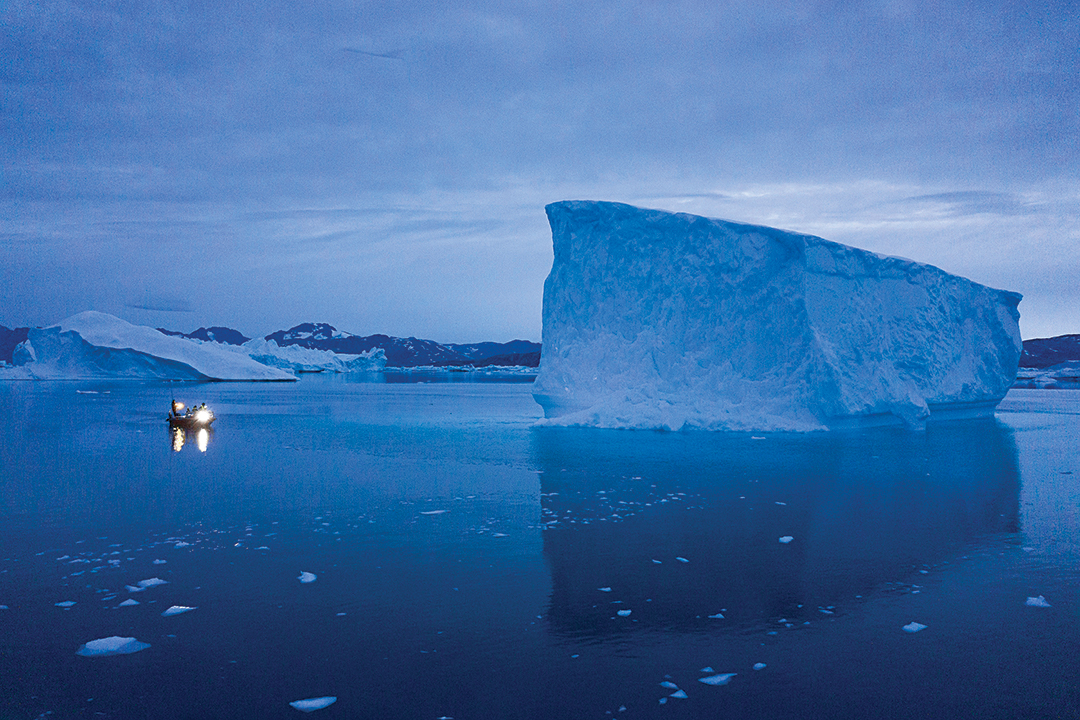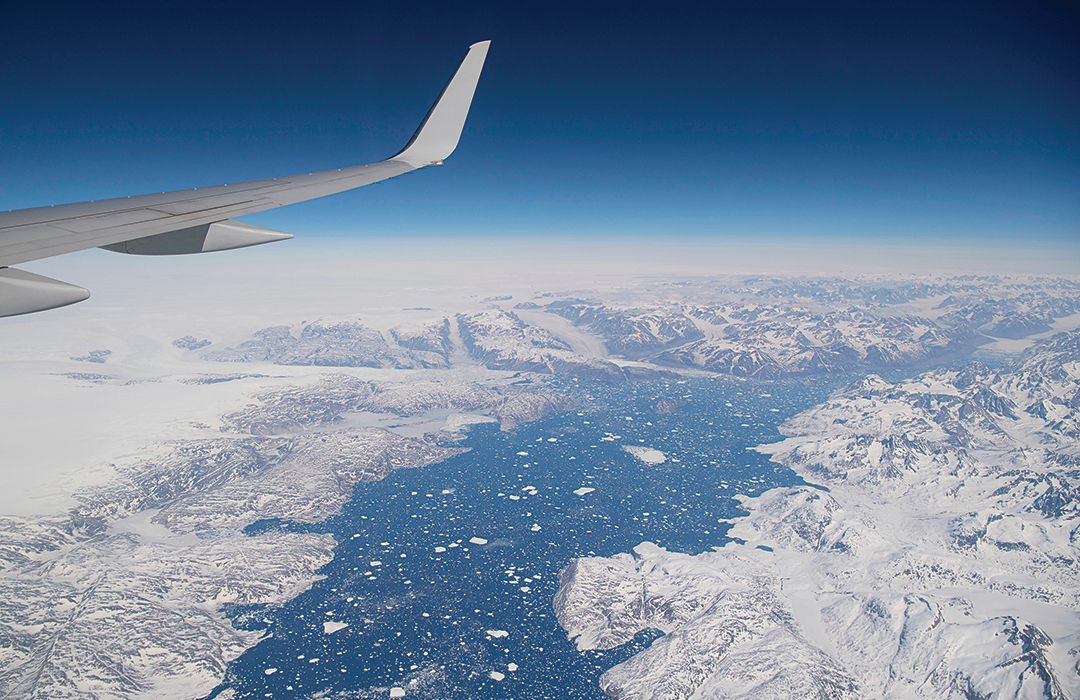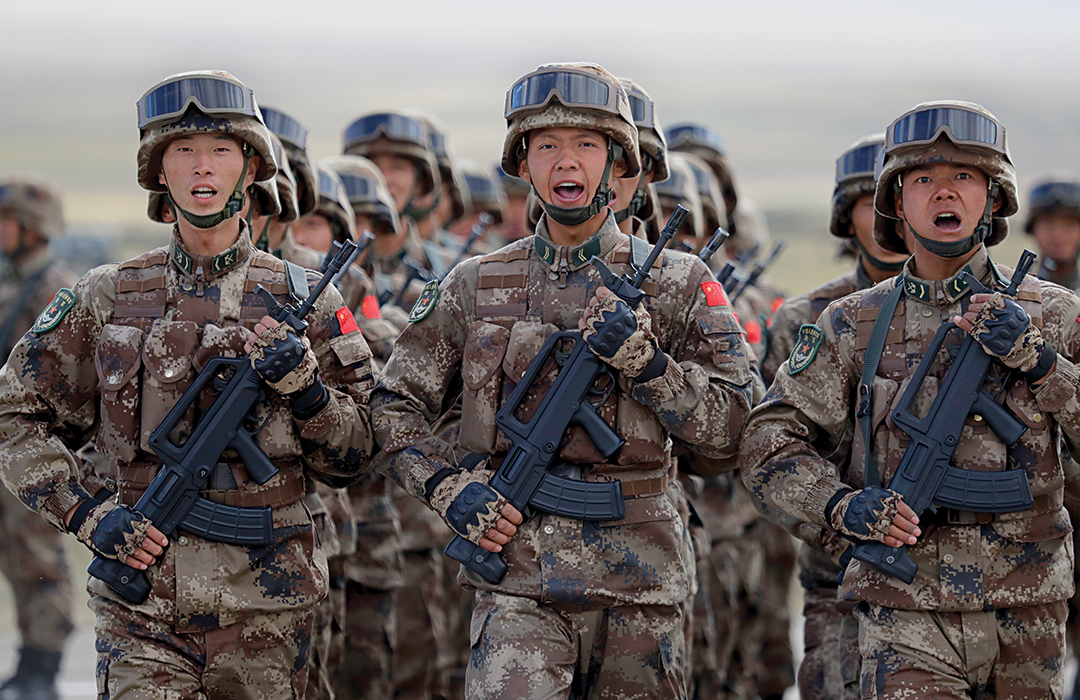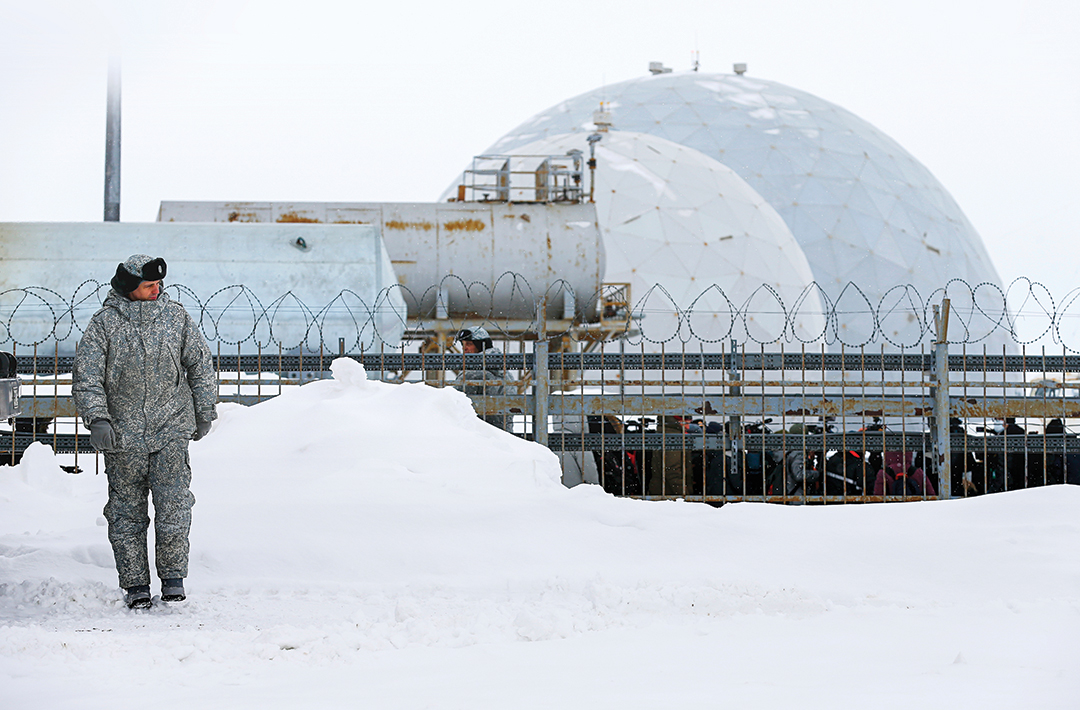Adopting a balanced approach
By Snorri Matthíasson, Icelandic Foreign Service officer and political advisor to NATO Joint Task Force Command Norfolk
Photos by The Associated Press
Canada, Denmark, Iceland, Norway and the United States were original signatories to the Washington Treaty, placing nearly half the Arctic Circle within NATO territory upon the Alliance’s founding in 1949. Aside from neutral Finland and Sweden, the remaining Arctic territory was the Soviet Union’s. With the Soviet Navy otherwise bottled up in the Baltic and Black seas, its Arctic ports offered unobstructed avenues for its naval forces to project power into the Atlantic. As intercontinental ballistic missiles (ICBMs), ballistic missile submarines (SSBNs) and long-range aviation grew in importance, the region was heavily securitized by both sides throughout the Cold War. While North America falls under NATO’s territory as defined by Article 6 of the North Atlantic Treaty, the defense of the North American continent quickly became a bilateral matter between the U.S. and Canada. The seeds of this bilateral arrangement were sown during World War II, and the relationship remains perhaps the most integrated in the Alliance today. Thus, NATO’s northern focus was from an early stage (and continues to be) centered on what is sometimes referred to as the European Arctic or the High North.
During the Cold War, the allies invested heavily in military capabilities and infrastructure to deter and, if necessary, defend against potential Soviet threats emanating from the Kola Peninsula. Primarily centered on northern Norway and the Greenland-Iceland-United Kingdom (GIUK) Gap, NATO’s approach to the High North was comprehensive despite the otherwise land-centric focus of the Alliance. The GIUK Gap, a naval chokepoint between the three countries, represented the defensive line separating the bulk of Soviet maritime forces from the all-important trans-Atlantic lines of communication. In World War II, the Battle of the Atlantic had been the longest campaign of the war, with nearly disastrous results for the Allies, and had already prompted the U.S. to heavily invest in infrastructure in the High North. To deter Soviet attempts to disrupt the trans-Atlantic lines of communication, the Allies developed not just the capabilities, but also the structures and facilities required to prevail in a potential third battle of the Atlantic. NATO’s Supreme Allied Commander Atlantic and his subordinate commanders played a key role in developing awareness of the Soviet submarine threat in an Alliance often criticized for its “sea blindness.” Toward the end of the Cold War, the U.S. Navy shifted its approach by applying pressure on the Soviet Navy farther north through its 1980 Maritime Strategy, forcing the Soviets to rethink assumptions about a potential conflict with the West.

Arctic change
The fall of the Soviet Union saw this confrontational dynamic soften considerably. NATO understandably shifted its approach to the new Russian Federation and developed partnerships with former Warsaw Pact members. Indeed, the post-Cold War NATO-Russia Founding Act, signed in 1997, was specifically aimed at recasting this relationship in terms of consultation and cooperation. The challenges of the post-Soviet Russian economy necessitated drastic cuts in defense spending, and the Russian Northern Fleet reduced both the numbers of platforms and the operational activity of those that survived. Overall, relations with Russia underwent fundamental changes that left the North Atlantic largely uncontested. NATO members took full advantage of the peace dividend, reducing their own defense budgets and gradually disbanding elements of the NATO Command Structure (NCS) that had focused on the Soviet threat throughout the Cold War.
Owing to an olive branch initially extended by Soviet leader Mikhail Gorbachev in 1987, the Arctic benefited from a vacation from geopolitics that allowed for cross-border cooperation and peaceful dialogue between former adversaries keen to reset relations. Much of this cooperation revolved around overdue environmental protections that could be implemented through the newfound spirit of cooperation and eventually culminated in the founding of the Arctic Council, as well as the Barents Euro-Arctic Council and the Council of the Baltic Sea States. All three provided venues for constructive dialogue with Russia under the auspices of regional cooperation, building trust, reducing tension and tackling common problems. The Arctic Council was not mandated to discuss military issues, but that did not cause many headlines at the time given the cordial relations with Russia. Though, in truth, the founding of the Arctic Council in 1996 did not generate many headlines at all because the world was focused on other issues and regions. This dialogue and the new structures ushered in an era of quiet cooperation that has been accurately described as “High North, low tension.”
But this view of the Arctic is increasingly coming under scrutiny from experts and observers as the region shifts from the quiet cooperation of the 1990s to a growing state of strategic importance today. The region has changed with the accelerating effects of climate change and the growing global reach of China opening up new avenues for strategic competition. This creates a new transpolar geopolitical dynamic in the Arctic; as Rebecca Pincus, assistant professor at the U.S. Naval War College, has convincingly argued, the GIUK Gap that was once the heart of an East-West confrontation is now increasingly the venue of an additional North-South dynamic. As accelerating climate change offers the prospect of new shipping lanes through previously impassable routes that could drastically shorten the journey time from Asia to Europe, the eyes of the world have turned to the Arctic.
Russia and China in the Arctic
While cooperation with Russia has all but collapsed in other areas since its invasion and annexation of Crimea in 2014, the Arctic states have had remarkable success in maintaining cooperation and dialogue. Owing in part to the exclusion of military affairs from the Arctic Council’s mandate, cooperation has continued, and the region remains well governed, all things considered. In the frenzied coverage of the Arctic “heating up,” it is often forgotten that a stable, secure Arctic is fundamentally in the interests of all the Arctic states, including Russia, and that is reflected in all their Arctic policies. The Russian Federation has 60,000 kilometers of international borders, and a soon-to-be navigable Northeast Passage offers not just a new and attractive alternative to the Suez Canal, but also a 25,000-kilometer frontier to securitize and defend.
Though scholars and experts are divided on the intent behind the redevelopment of Russia’s military infrastructure along the Northeast Passage, there can be no doubt as to the capabilities of its assets in the region and Russia’s disregard for international law elsewhere in Europe. Norway has led the way in analyzing the modern Russian Bastion Defense Concept and raised concerns about its potential impact on allied security. When U.S. Navy Adm. James Foggo, then commander of the U.S. 6th Fleet, spoke of Russian submarines “prowling the Atlantic, testing our defenses” he was referring to the assets of Russia’s revamped Northern Fleet, sailing from the Kola Peninsula through the Bear Gap and GIUK Gap into the Atlantic.

China’s presence
Discussions of Chinese activity in the Arctic, while especially prone to exaggerations and half-truths, have led to concerns in Arctic capitals about long-term Chinese intent. This was crystallized in the approach of then-U.S. President Donald Trump’s administration at the 2019 Arctic Council ministerial meeting in Rovaniemi, Finland, that has been carried through to current U.S. President Joe Biden’s administration and resonates with many allies. As NATO Secretary-General Jens Stoltenberg often says of China: “We see them in Africa, we see them in the Arctic.” China has increased its economic, scientific and diplomatic activity in the High North, often under the banner of a “Polar Silk Road” — the northern component to its Belt and Road program. China’s infamous self-designation as a “near-Arctic state” caused concern — and not just among the Arctic NATO members. At the 2021 Brussels summit, NATO leaders approved a communique that spoke explicitly to allied concerns about China’s stated ambitions, assertive behavior and the potential threat to the rules-based international order.
Reacting to change
To ignore these developments in the High North would be unwise. But at the same time, to overreact to the natural evolution of changing national interests in the Arctic would be counterproductive and could even cause inadvertent escalation. Most threat assessments, both national and academic, consider the threat of conflict in the Arctic to be low, but note that the outbreak of conflict elsewhere would likely spill over into the vulnerable Arctic. Early considerations of the post-Cold War Arctic were met with divergent views among allies on what role NATO should play, if any. Initially, the focus was on less than conventional (but no less pressing) security issues such as the implications of climate change or search and rescue coordination in isolated regions. But over the past decade, this divergence of views has gradually been bridged, driven by allied concerns about rapidly accelerating climate change, Russian activity and increased international interest in the region. At the 2009 Strasbourg-Kehl summit, NATO included a reference to developments in the High North, noting the increased international attention and security-related developments (including climate change) after a high-level symposium on Arctic security hosted by Iceland.
In 2008, Norway initiated the Core Area Initiative, a campaign to strengthen and regionalize the NCS and revitalize collective defense in Europe. Its view was that while out-of-area operations were important to maintain the security of the Euro-Atlantic area, this should not result in forgetting or ignoring the core area. The initiative was supported by Norwegian threat assessments, academic writings and active lobbying by Norwegian civilian and military leadership. Six years later, the Core Area Initiative felt rather prophetic as events in Ukraine fundamentally changed assumptions about a Europe whole, free and secure.
As the Arctic has grown in strategic importance, there has been a proliferation of writing on the region that has some journalists and think tank experts whipped into a near frenzy. In fact, there are so many ill-conceived hot takes on the cold region that there exists a subculture among Arctic experts poking fun at the oversimplifications and exaggerated conclusions drawn about Russian or Chinese plots for world domination through melting sea ice or endless supplies of hydrocarbons awaiting extraction from the North Pole. (See for example Heather Exnot-Pirot’s 2018 article, “How to write an Arctic story in 5 easy steps,” on the ArcticToday website.) A lot of this Arctic writing is highly prescriptive, with detailed suggestions for what NATO should do, or what new structures or standing Arctic forces it should establish to deal with the conflict that appears to be already underway. However, the reality on the ground does not necessarily reflect some of these dramatic descriptions. The same writing often criticizes the Alliance for inaction, but NATO’s considered approach to the Arctic reflects the benefit of an Alliance whose actions are driven by regular political consultations on security issues among its 30 members. This has allowed the Arctic allies to collectively guard against the risk of overreaction in a delicate region. Still, with time the Alliance has taken a series of measured steps to ensure the freedom and security of its members’ citizens in the High North, both in terms of the decisions made by the Alliance and by the actions taken by allies.

NATO’s role
The first step for NATO was to increase situational awareness in a changing Arctic. In a vast region largely covered by ocean, and with limited infrastructure and population, it is crucial that the Alliance does not allow an adversary to accrue any advantage through undetected activity. Improved situational awareness is being pursued through the increased presence of allied nations in terms of new investments in intelligence, surveillance and reconnaissance capabilities, anti-submarine warfare (ASW) platforms and deployments that test the ability of existing forces to operate in austere conditions. Changes to the NCS have also enabled NATO to play a coordinating role for national activity, improving the effectiveness of Alliance forces and reducing the risk of miscalculation. This will help the allies and NATO’s principal committees make informed decisions in peace, crisis and conflict.
In 2016, leaders at the Warsaw summit initiated the NATO Command Structure Adaptation with the aim of making the NCS once again fit for purpose in a changed security environment. Two years later, the allies agreed to establish two new commands: Joint Support and Enabling Command, to ensure freedom of operation and sustainment in the rear area, and Joint Force Command (JFC) Norfolk, to focus on protecting the trans-Atlantic lines of communication. At the same time, the U.S. Navy reestablished the 2nd Fleet, closely integrated with JFC Norfolk through its dual-hatted commander. That same year, NATO held Trident Juncture 2018 (TRJE18), its largest exercise since the end of the Cold War. In hosting TRJE18, Norway had an opportunity to exercise its own national defense plans, Host Nation Concept Support and Total Defense Concept. Other exercises, both NATO and national, continue to look north as allied forces develop their capability to operate in this austere and challenging environment. Dynamic Mongoose, a NATO-led ASW exercise, is now hosted in Iceland or Norway in alternating years. National-led exercises such as Cold Response, Joint Warrior and Northern Viking have been reestablished or reinvigorated. In 2019, NATO adopted a new military strategy as part of the broader adaptation to the changed security environment. Based on this strategy, the allies have approved both a concept for operationalizing the strategy, as well as a framework for the development of NATO’s military instrument of power. This approach is fundamentally theaterwide, taking into consideration not just a single region but, crucially, the totality of the Supreme Allied Commander Europe’s area of responsibility. As such, NATO is able to address regional concerns and the interplay between regions, consistent with NATO’s fundamental values of shared purpose and a 360-degree approach to collective defense.
Allied action
In addition to NATO’s structural adaptation, the allies have steadily increased defense budgets since 2014 in accordance with the Defense Investment Pledge. This is a crucial step, since many of the capabilities and platforms required for successful deterrence in the North Atlantic were retired after the Cold War, with key expertise allowed to atrophy. Several allies have dedicated funding to the type of capabilities and platforms crucial to the Cold War confrontation in the North Atlantic and Arctic. Today, as during the Cold War, the overwhelming majority of military activity in the North Atlantic is conducted on a national basis, rather than formally under a NATO operation. However, allies are increasingly coordinating those national activities under a NATO umbrella and enabling information sharing that contributes to overall Alliance readiness and situational awareness. This activity, led by national military headquarters, is then combined and coordinated with NATO activity, such as regular air policing missions in Iceland or the flexible NATO standing naval forces.
The U.S. has led the way in the High North, increasing military deployments to Arctic allies and partners since 2014. These efforts are supported by a flurry of Arctic strategies as land, amphibious, naval and air forces have all been deployed north to develop their abilities to operate in the region and strengthen the deterrence and defense posture. The U.S. has also reinvigorated existing economic and diplomatic ties that underpin Alliance cohesion (recall Article 2 of the North Atlantic Treaty), signed a nonbinding trilateral security agreement with Finland and Sweden in 2018, and developed a relationship with the Greenlandic government. And while neither the United Kingdom nor France are Arctic nations, both have taken an interest in developments in the north, working with allies to develop cold weather capabilities and conducting cooperative deployments. This is particularly the case in the maritime domain, where UK vessels have operated in the Barents Sea, and in 2018, the French ship BSAH Rhône sailed through the Northeast Passage.
Smaller allies, such as Norway and Denmark, have by virtue of geography always maintained a military presence in the High North and retained capabilities that other allies retired. Norway’s Cold Response 2022 will, according to the country’s Chief of Defense, be the largest military exercise inside the Arctic Circle in Norway since the 1980s, involving 40,000 soldiers. Norway also maintains the NATO Centre of Excellence – Cold Weather Operations, focusing on developing the Alliance’s ability to conduct operations in the extreme cold. In 2020, the Danish Joint Arctic Command in Nuuk, Greenland, signed a memorandum of understanding with Allied Maritime Command to develop shared situational understanding in the region. In February 2021, Denmark announced a new Arctic Capability package of $240 million to develop intelligence, surveillance and reconnaissance, and increase its footprint in and around Greenland and the Faroe Islands, set to be firmly rooted in a NATO effort.
The 2021 Brussels summit set the stage for NATO’s continued adaptation to the ever-changing security environment. Allied leaders agreed to strengthen political consultations and address the security impact of climate change, decisions that will continue to improve its ability to deal with issues in the High North. The revision of the Strategic Concept offers an opportunity for the allies to reflect on and review NATO’s approach to not just the North, but also the East, South and West. The communique included a careful reference to the High North, wherein NATO “will continue to undertake necessary, calibrated, and coordinated activities in support of the Alliance’s security interests.” The statement was not isolated from other regions, but was part of an assessment of the challenging security environment across Supreme Allied Commander in Europe’s AOR. This is consistent with NATO’s 360-degree approach to security and defense.

Conclusion
NATO is fundamentally based on the concept of one for all, all for one. NATO should, and does, concern itself with the security and defense of the High North, just as it concerns itself with security and defense elsewhere. It does so with an emphasis on a balanced approach that recognizes regional sensitivities and leverages local, nuanced understandings to avoid provocation or escalation. In the context of the High North, this has been underlined on numerous occasions by NATO’s senior leaders and is helped by the active work of the five Arctic allies within the committees and hallways of NATO headquarters and in the NCS. These five nations would also be likely leaders in developing situational awareness in any brewing crisis, enabling the North Atlantic Council to reach timely and informed consensus.
The challenge for NATO in the High North is simple: Don’t believe the hype, but don’t ignore it either. Through consensus-based decisions, NATO is adopting a balanced approach to the changes that can ensure the freedom and security of its member states’ citizens while maintaining low tensions in the High North. By giving even the smallest member a chance to apply the brakes, NATO ensures that all its decisions and actions represent the collective will of its 30 allies. No doubt, this seems slow and inefficient at times, but when it comes to formulating policy and doctrine, it allows for a careful and coordinated adaptation that will inform the North Atlantic Council in times of crisis. This “slow and steady wins the race” approach is one of the key reasons for the enduring success of the Alliance.
Editor’s note: This article was completed prior to Russia’s illegal escalation of aggression against Ukraine in February 2022, and before Finland and Sweden were invited to join NATO.


Comments are closed.